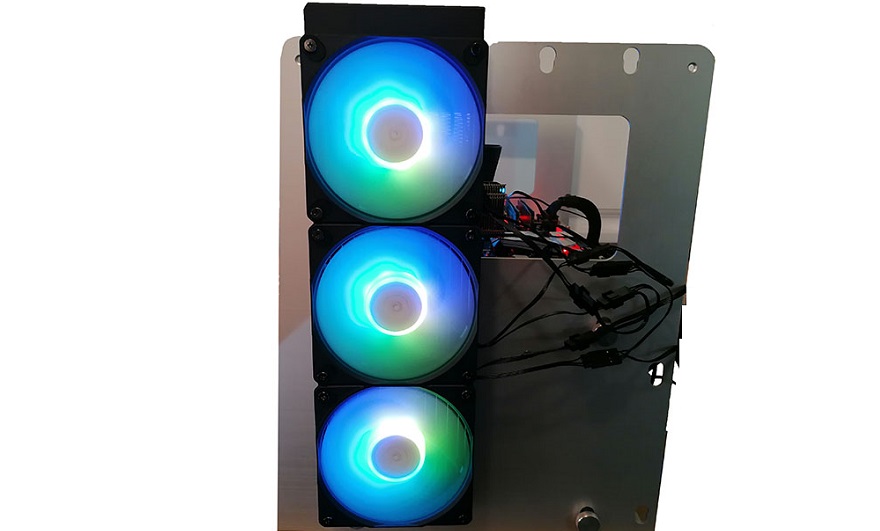InWin BR36 AIO Liquid CPU Cooler Review
Mike Sanders / 4 years ago
A Closer Look
The first thing that immediately grabs your attention when you get the InWin BR36 out of the box is that cooling cone fan located to the pump head. Let us not wax lyrical over one individual part, however, because, as I’m sure you are aware, there are many separate individual components that go into an AIO’s design. Let us, therefore, take a closer look and see what makes this thing tick… or glug.

Water Block
Without a doubt, one of the biggest party pieces of this AIO coolers design is that relatively unique design to the water block. Incorporating a cone-like fan to supposedly help cool the upper motherboard area and components, it isn’t overly dissimilar to something like the AMD Wraith stock cooler and it’s certainly impressive if not mildly intimidating to behold.

With the ARGB currently off, and yes the light show is on here too, the fan does look rather nice with its nice circular design and particularly so the InWin logo to the centre. It somehow manages to not look unusual or peculiar despite this being a relatively rare component seen in AIO designs.

Admittedly, it is rather large. Despite this, there should be absolutely no problems in terms of space or RAM compatibility and nor does it look obscenely grotesque when fitted to a motherboard. In fact, it looks rather cool. As such, while the benefits of its inclusion can be debated, it surely can’t do any harm in terms of performance.

Contact Plate
Given that the InWin BR36 is TR4 compatible (along, of course, with all other major Intel and AMD sockets), it’s not exactly surprising to see that the contact place is huge. However, with its gleaming copper surface, we’re more than a little optimistic that we can expect some nice low CPU temperatures from this.

Radiator
At an initial glance, the radiator does appear to be a rather standard affair. Basically, it looks pretty much like all the other ones used on 360mm AIO coolers. However, this one still manages to have a few little tricks up its sleeve, which should result in some nice performance figures.

Firstly, a closer look at the fins certainly speaks of a quality design here. While closely interwoven, there is still plenty of room between them to allow for a good positive flow of air.

What is interesting though is the fact that it would appear that the pump mechanism is sat near the radiator physically on the hose. Although this isn’t unique, it’s a design option we don’t see utilized much. One convenient aspect of this though is that the 3-pin power cable coming off this is far more conveniently located for users to easily fit this onto their motherboard. And when it comes to 360mm AIO coolers with ARGB lighting, we’ll take all the cable management we can get!

Fans
As this is a 360mm AIO liquid cooler, I don’t think would surprise you to learn that you are provided with 3 x 120MM fans. Well, not including the once aforementioned attached to the water block.

Being an InWin own design, the LUNA AL120 certainly comes with a decent reputation. Given that these are known to be almost ‘extreme’ level of performance fans, it’ll be interesting to see how they work out in terms of temperature control, and perhaps more notable, noise levels.

As a set, though, they actually look really nice. Albeit, we do expect that to be kicked up a notch once the ARGB lighting is all hooked up and turned on.

ARGB in Action
Although we will discuss the ARGB lighting more detail in the installation part of this review, it would be remiss of us if we didn’t give you something of an early doors taste as to what you can expect.

The lighting effects are amazingly bright, bold, vivid, and thanks to the inclusion of a manual controller, you don’t even need an ARGB compatible motherboard for them to work. Yes, as always, ARGB motherboards are usually the best way to connect, but having the controller is certainly a handy option for those of you on more limited and/or older hardware.

Overall
As an assembled unit, the InWin BR36 certainly looks like an impressively imposing creature. However, even with the lights turned off, I personally find it an attractive design; it looks good without even trying.

Looks are, however, only one aspect of this review. While the individual components of this design certainly give us some encouragement, there is still the matter of how easy this is to install and, perhaps more importantly, how well this performs in our tests. With that in mind, therefore, let’s see if we can get this fitted to our test bench and how long that process takes us!




















